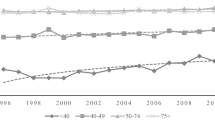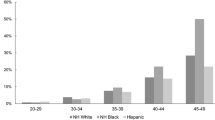Abstract
Objectives
The aim of this study is to explore incidence and incidence-based mortality trends for endometrial cancer in the USA and project future incident cases, accounting for differences by race and histological subtype.
Methods
Data on age-adjusted and age-specific incidence and mortality rates of endometrial cancer were obtained from the Surveillance, Epidemiology, and End Results 18 registries. Trends in rates were analyzed using Joinpoint regression, and average annual percent change (AAPC) in recent years (2006–2011) was computed for histological subtypes by race. Age, histological, and race-specific rates were applied to US Census Bureau population census estimates to project new cases from 2015 to 2040, accounting for observed AAPC trends, which were progressively attenuated for the future years.
Results
The annual number of cases is projected to increase substantially from 2015 to 2040 across all racial groups. Considerable variation in incidence and mortality trends was observed both between and within racial groups when considering histology.
Conclusions
As the US population undergoes demographic changes, incidence of endometrial cancer is projected to rise. The increase will occur in all racial groups, but larger increases will be seen in aggressive histology subtypes that disproportionately affect black women.
Similar content being viewed by others
References
Sorosky JI. Endometrial cancer. Obstet Gynecol. 2012;120:383–97. doi:10.1097/AOG.0b013e3182605bf1.
Siegel RL, Miller KD, Jemal A. Cancer statistics, 2015. CA Cancer J Clin. 2015;65:5–29. doi:10.3322/caac.21254.
Burke WM, Orr J, Leitao M, Salom E, Gehrig P, Olawaiye AB, et al. Endometrial cancer: a review and current management strategies: part i. Gynecol Oncol. 2014;134:385–92. doi:10.1016/j.ygyno.2014.05.018.
Howlader N, Noone AM, Krapcho M, Garshell J, Miller D, Altekruse SF, (eds) et al. SEER cancer statistics review, 1975–2012, National Cancer Institute. Bethesda, MD, http://seer.cancer.gov/csr/1975_2012/, based on November 2014 SEER data submission, posted to the SEER web site, April 2015.
Long B, Liu FW, Bristow RE. Gynecologic oncology disparities in uterine cancer epidemiology, treatment, and survival among African Americans in the United States. Gynecol Oncol. 2013;130:652–9. doi:10.1016/j.ygyno.2013.05.020.
Jamison PM, Noone A-M, Ries LAG, Lee NC, Edwards BK. Trends in endometrial cancer incidence by race and histology with a correction for the prevalence of hysterectomy, SEER 1992 to 2008. Cancer Epidemiol Biomark Prev. 2013;22:233–41. doi:10.1158/1055-9965.EPI-12-0996.
Allard JE, Maxwell GL. Race disparities between black and white women in the incidence, treatment, and prognosis of endometrial cancer 2009;16.
Maxwell GL, Tian C, Risinger J, Brown CL, Rose GS, Thigpen JT, et al. Racial disparity in survival among patients with advanced/recurrent endometrial adenocarcinoma: a gynecologic oncology group study. Cancer. 2006;107:2197–205. doi:10.1002/cncr.22232.
Murali R, Soslow RA, Weigelt B. Classification of endometrial carcinoma: more than two types. Lancet Oncol. 2014;15:e268–78. doi:10.1016/S1470-2045(13)70591-6.
Smith BD, Smith GL, Hurria A, Hortobagyi GN, TA B. Future of cancer incidence in the United States: burdens upon an aging, changing nation. J Clin Oncol. 2009;27:2758–65. doi:10.1200/JCO.2008.20.8983.
Rahib L, Smith BD, Aizenberg R, Rosenzweig AB, Fleshman JM, Matrisian LM. Projecting cancer incidence and deaths to 2030: the unexpected burden of thyroid, liver, and pancreas cancers in the United States. Cancer Res. 2014;74:2913–21. doi:10.1158/0008-5472.CAN-14-0155.
Sheikh MA, Althouse AD, Freese KE, Soisson S, Edwards RP, Welburn S, et al. USA endometrial cancer projections to 2030: should we be concerned? Future Oncol. 2014;10:2561–8. doi:10.2217/fon.14.192.
Surveillance, Epidemiology, and End Results (SEER) Program (www.seer.cancer.gov) SEER*Stat Database: Incidence - SEER 18 Regs Research Data + Hurricane Katrina Impacted Louisiana Cases, Nov 2013 Sub (1973–2011 varying) - Linked To County Attributes - Total U.S., 1969–2012 Counties, National Cancer Institute, DCCPS, Surveillance Research Program, Surveillance Systems Branch, released April 2014 (updated 5/7/2014), based on the November 2013 submission.
Surveillance Research Program, National Cancer Institute SEER*Stat software (www.seer.cancer.gov/seerstat) version 8.1.5. n.d.
Fritz A, Percy C, Jack A, Shanmugaratnam K, Sobin L, Parkin DM, et al. International classification of diseases for oncology. Third. World Health Organization; 2001.
Brinton LA, Felix AS, McMeekin DS, Creasman WT, Sherman ME, Mutch D, et al. Etiologic heterogeneity in endometrial cancer: evidence from a gynecologic oncology group trial. Gynecol Oncol. 2013;129:277–84. doi:10.1016/j.ygyno.2013.02.023.
United States Census Bureau. 2012 National population projections: downloadable Files. http://www.census.gov/population/projections/data/national/2012/downloadablefiles.html. Accessed April 6, 2015. n.d.
Joinpoint Regression Program, Version 4.1.1.4 - February 2015; Statistical Methodology and Applications Branch, Surveillance Research Program, National Cancer Institute. n.d.
Virani S, Sriplung H, Rozek LS, Meza R. Escalating burden of breast cancer in southern Thailand: analysis of 1990-2010 incidence and prediction of future trends. Cancer Epidemiol. 2014;38:235–43. doi:10.1016/j.canep.2014.03.003.
Kurman RJ, Carcangiu ML, Herrington CS, Young RH. WHO classification of tumours of female reproductive organs. Fourth. Lyon: IARC Press; 2014.
Tavassoli F, Devilee P, editors. World Health Organization classification of tumours: pathology and genetics: tumours of the breast and female genital organs. Lyon: IARC Press; 2003.
Fader AN, Arriba LN, Frasure HE, von Gruenigen VE. Endometrial cancer and obesity: epidemiology, biomarkers, prevention and survivorship. Gynecol Oncol. 2009;114:121–7. doi:10.1016/j.ygyno.2009.03.039.
Renehan AG, Tyson M, Egger M, Heller RF, Zwahlen M. Body-mass index and incidence of cancer: a systematic review and meta-analysis of prospective observational studies. Lancet. 2008;371:569–78. doi:10.1016/S0140-6736(08)60269-X.
Setiawan VW, Yang HP, Pike MC, McCann SE, Yu H, Xiang YB, et al. Type I and II endometrial cancers: have they different risk factors? J Clin Oncol. 2013;31:2607–18. doi:10.1200/JCO.2012.48.2596.
Ogden CL, Carroll MD, Kit BK, Flegal KM. Prevalence of childhood and adult obesity in the United States, 2011-2012. JAMA. 2014;311:806–14. doi:10.1001/jama.2014.732.
Weiss JM, Saltzman BS, JA D, LF V, Chen C, Beresford SAA, et al. Risk factors for the incidence of endometrial cancer according to the aggressiveness of disease. Am J Epidemiol. 2006;164:56–62. doi:10.1093/aje/kwj152.
Cote ML, Alhajj T, Ruterbusch JJ, Bernstein L, Brinton LA, Blot WJ, et al. Risk factors for endometrial cancer in black and white women: a pooled analysis from the epidemiology of endometrial cancer consortium (E2C2). Cancer Causes Control 2014;26:287–296. doi:10.1007/s10552-014-0510-3.
Beining RM, Dennis LK, Smith EM, Dokras A. Meta-analysis of intrauterine device use and risk of endometrial cancer. Ann Epidemiol. 2008;18:492–9. doi:10.1016/j.annepidem.2007.11.011.
Farquhar CM, Steiner CA. Hysterectomy rates in the United States 1990-1997. Obstet Gynecol. 2002;99:229–34.
Kavanaugh ML, Jerman J, Finer LB. Changes in use of long-acting reversible contraceptive methods among United States women, 2009-2012. Obstetrics & Gyn. 2015;126(5):917–27.
Wright JD, Herzog TJ, Tsui J, Ananth CV, Lewin SN, Lu Y, Neugut AI, Hershman DL. Nationwide trends in the performance of inpatient hysterectomy in the United States. Obstet Gynecol. 2013;122(2 0 1):233–41.
Acknowledgments
Dr. Meza acknowledges the support of the Department of Epidemiology at the University of Michigan. Mr. Gaber was partially supported by a Dean’s award from the School of Public Health, University of Michigan and the Karmanos Cancer Institute (2P30CA022453-34).
Author information
Authors and Affiliations
Corresponding author
Ethics declarations
This article does not contain any studies with animals performed by any of the authors. For this type of study, formal consent is not required.
Conflict of Interest
The authors declare that they have no conflict of interest.
Rights and permissions
About this article
Cite this article
Gaber, C., Meza, R., Ruterbusch, J.J. et al. Endometrial Cancer Trends by Race and Histology in the USA: Projecting the Number of New Cases from 2015 to 2040. J. Racial and Ethnic Health Disparities 4, 895–903 (2017). https://doi.org/10.1007/s40615-016-0292-2
Received:
Revised:
Accepted:
Published:
Issue Date:
DOI: https://doi.org/10.1007/s40615-016-0292-2




